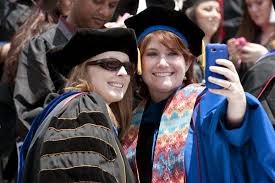Flexibility
within the post-secondary education landscape is evolving fast. More students
than ever are going back to school seeking a career change or a leg up in their
current positions, more often than not those students tend to be women.
 Interestingly,
the trend in degree choice for women seems to be in business management. Female
employees who study make up 28 percent, while males make up only 24 percent
(NECS).
Interestingly,
the trend in degree choice for women seems to be in business management. Female
employees who study make up 28 percent, while males make up only 24 percent
(NECS).
I
spoke to Dawn McClintock (who is also getting her bachelors in business management)
about her hypothesis as to why women’s enrollment has exceeded their male
counterpart. “We have always wanted the education, but it was less feasible
before. Universities are starting to get
it now, women have a lot on their plates—especially working mothers. I don’t
think that I would have been able to do this even 10 years ago, but now colleges
are structuring programs that fit into our packed schedules.”
Many
colleges are catering to not only the nontraditional student, but specifically
to women. Some of the programs include:
Mt Holyoke’s Francis Perkins Program (specifically targeting older students),
Smith College’s Ada Comstock Scholars Program, and Yale University’s—highly
competitive Eli Whitney Program.
The American Association of University Women claim that nearly 60 percent of online students are women, and the majority over the age of 25.
"I take as many classes online as possible," says Brooke Hackett, mother, and full time worker. "Its the most convenient and practical way to integrate school into my life, otherwise I think I would be missing out on some of the best years with my kids."According to the US Census Bureau since the 1980's the rate of women's enrollment in higher learning facilities has doubled to almost 12 million.
"I would be shocked if there wasn't a direct correlation between more online courses being offered and the rise in women attending college," says Hackett. "We can have our cake and eat it too."


